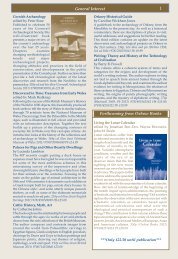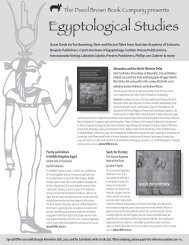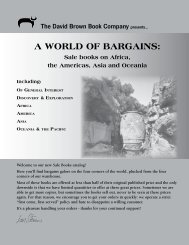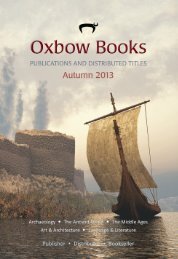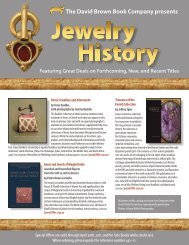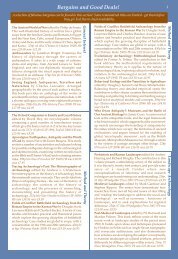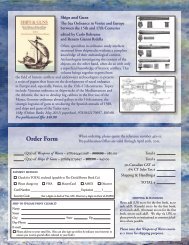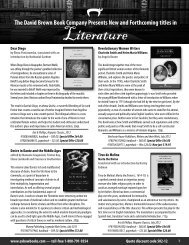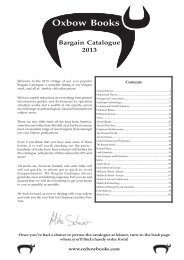Oxbow Spring 2013.pdf - Oxbow Books
Oxbow Spring 2013.pdf - Oxbow Books
Oxbow Spring 2013.pdf - Oxbow Books
Create successful ePaper yourself
Turn your PDF publications into a flip-book with our unique Google optimized e-Paper software.
A Road Through the Past<br />
Archaeological discoveries on the A2 Pepperhill to Cobham road-scheme in Kent<br />
Alan Hardy (Author); Kelly Powell (Author); Tim Allen (Author); Michael Donnelly (Author)<br />
Excavations along the new road line have revealed nearly 6000 years of human<br />
activity, from a massive marker post erected by early Neolithic farmers at the<br />
head of a dry valley to a bizarre burial of several different animals dating to<br />
the sixteenth century AD. Most exciting were rich cremation burials of the late<br />
Iron Age and early Roman periods, probably successive generations of a local<br />
family, whose rise to prominence coincides with the growth of the cult centre at<br />
<strong>Spring</strong>head nearby. The metal vessels include types new to Britain, the pottery<br />
stamps suggest the movement of continental potters to Kent, and one grave has<br />
the clearest evidence of furniture yet found from early Roman Britain. Medieval<br />
settlements of the late 11th–14th centuries mirror the renewed importance of<br />
Watling Street after the Norman conquest, and its eventual return to obscurity<br />
due to competition from the ferry from London to Gravesend.<br />
9780904220681, £32.00, Available Now<br />
HB, 620p, 267 illus & 91 plates (mostly colour), OA Monograph Series 16, Oxford Archaeology<br />
British Archaeology – Multi-Period Excavations<br />
10<br />
From Mesolithic to Motorway<br />
The Archaeology of the M1 (Junction 6a–10) Widening Scheme, Hertfordshire<br />
Andrew Simmonds (Editor); Paul Booth (Editor); Dan Stansbie (Editor); Valerie Diez (Editor)<br />
Excavation in advance of engineering works along the M1 from Junctions 6a to<br />
10 (between Hemel Hempstead and Luton) revealed significant archaeological<br />
remains of wide-ranging date. Important evidence for late Mesolithic and early<br />
Neolithic activity, including pits, was found at Junction 9, while later prehistoric<br />
features were more widely distributed but less concentrated. Late Iron Age<br />
and Roman features were most common, with significant rural settlements at<br />
Junctions 8 and 9, and further evidence for trackways and enclosures elsewhere.<br />
Occupation was most intensive in the 1st–2nd centuries AD and on a reduced<br />
scale in the late Roman period. At Junction 8, however, an east-west trackway<br />
apparently survived as a landscape feature and in the 12th and 13th centuries<br />
was adjoined by a ditched enclosure containing structures belonging to a<br />
substantial farmstead.<br />
9780904220650, £20.00, January 2013<br />
PB, 230p, 110 illus., Oxford Archaeology Monographs 14, Oxford Archaeology<br />
London Gateway<br />
Iron Age and Roman salt making in the Thames Estuary, Excavation at Stanford<br />
Wharf Nature Reserve, Essex<br />
Edward Biddulph (Editor); Elizabeth Stafford (Editor); Stuart Foreman (Editor); Dan<br />
Stansbie (Editor)<br />
Excavation by Oxford Archaeology in 2009 during construction of the Stanford<br />
Wharf Nature Reserve, funded and supported by the developer, DP World London<br />
Gateway, uncovered remarkable evidence for Iron Age and Roman-period salt<br />
making and associated activities. Structures included a probable boathouse,<br />
unique in Roman Britain. The excavations shed new and important light on<br />
evolving methods of salt production, which reflect wider changes in economy and<br />
society in the Thames Estuary between c. 400 BC and AD 400. Salt had a particular<br />
economic importance in the ancient world as a food preservative – changing scale<br />
and methods of production provide an essential background for understanding<br />
processes such as urbanisation, civilian trade and military supply.<br />
9789491431074, £42, August 2012<br />
9780904220711, £20.00, January 2013<br />
HB, 475p, Groningen Archaeological Studies 19, Barkhuis<br />
HB, 209p, 178 (mostly col.), Oxford Archaeology Monographs 18, Oxford Archaeology




